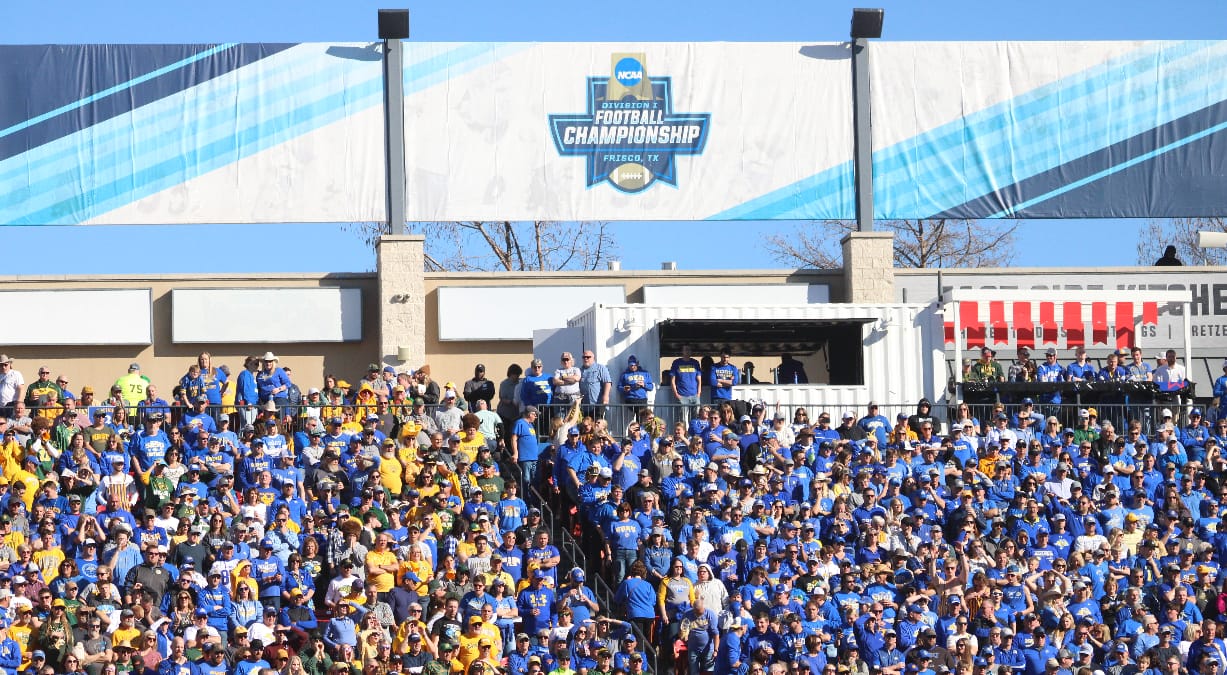The FCS Daily Dose is a blog-style article series featuring an assortment of news, rumblings, quick hitters, and commentary on various topics.
A new Daily Dose will be published multiple times a week.
New Customer Offers at BetMGM
Bonus Bets Expire in 7 Days. One New Customer Offer Only. Add’l Terms
UND, NDSU Athletes Now Have 3 Ways To Earn Money
The two FCS teams in North Dakota are showing their continued commitment and investment in athletics success.
Some FCS-level athletic departments offer cost of attendance. Some have NIL collectives. Some do Alston payments.
We can only think of two FCS-level programs that offer all three to its athletes: North Dakota and North Dakota State.
Cost of attendance has been around for several years. It’s for student-athlete expenses beyond tuition, fees, room and board, and books. Payments are usually between $3,000-$4,000 per year for a full-scholarship athlete, or a smaller portion of that for partial-scholarship players. The money can be used for whatever student-athletes desire — rent, food, gas, airplane ticket home, entertainment, etc.
UND and NDSU have offered full cost of attendance to all of its scholarship athletes since 2016.
NIL collectives are taking over the purity of college athletics and are getting more common in the FCS. They are independent of a university or athletic department and pool funds from donors to help create paid NIL opportunities for players. But really, it’s a way for top college programs to pay players huge sums of money, and all the player has to do for it to be within the rules of receiving that money is some type of “service,” whether that’s a social media post, a community event or appearance, or something else.
An NIL collective for NDSU sports, called The Green and The Gold Collective, launched before the 2023 football season. UND supporters followed, launching the 1883 Collective a couple of months ago.
Alston payments are financial rewards for athletes based on academic success. Payments to players can range from $3,000 to a maximum of $5,980 per school year.
UND announced last summer that it will offer Alston Awards, awarding about $960,000 annually to its athletes. Half of the funding will come from the athletic department and the other half will be initially funded by strategic investment dollars from the university. NDSU followed, announcing last week it will also offer Alston payments. It will award around $1.5 million to all athletes, funded by an endowment started by donors.
So now, some UND and NDSU athletes can earn nearly $10,000 per year depending on their scholarship amount and academic performance on top of whatever the NIL collective can pay plus any individual NIL deals specific players can strike on their own. And of course, all of that on top of having their tuition paid for.
Can this contend with the absurd NIL collective dollars that Power 4 teams can offer? No. But it will certainly help player recruitment and retention.
Frankly, “cost of attendance” and “Alston payments” should be sexier words than “NIL collective” for mid-major recruits and their parents. School A may have an NIL collective, but that collective may not be able to give each player as much money as School B with cost of attendance and no NIL collective.
Coaches in North Dakota can talk about all three on the recruiting trail.
Times have changed in the FCS. In the 1980s, 90s, 2000s, and early 2010s, competing at a national title level usually meant hitting on consecutive recruiting classes, retaining (much easier back then) and developing those recruits, and also who got hot come playoff time. It resulted in more parity.
In today’s FCS landscape, it takes an FBS level of investment to compete at a national championship level. Not many teams can reach that current bar to win a title, either because they don’t want to invest that much resources into mid-major football or because they don’t have the internal and external support to do so.
Some Midwest folks say the FCS is turning into D2 with the movement of teams via realignment. That’s a bit exaggerated. There are a lot of FCS lifers still in the subdivision who have a strong history of success. But this isn’t your father’s FCS anymore when it comes to winning a title. Probably to the chagrin of some traditionally strong FCS teams, the level of investment needed to compete is at an all-time.
NDSU (still the top FCS program even though South Dakota State is the top team) and UND (making strides to catch NDSU and SDSU, and who dominated the Bison last fall) have reset the bar in the off-the-field investments needed to compete on the field when it comes to athlete pay. Plus, their facilities are among the best in the FCS as well.
We’ll see how many FCS teams match them.
Other Daily Doses
FCS Players In The Athletic’s 7-Round NFL Mock Draft & In ESPN’s Top 400 Prospects … READ MORE
Don’t Expect Transfer Portal Restrictions Or Guardrails To Slow Down Player Movement … READ MORE
Why Monday Night Is The Best Option For The FCS Championship + McDowell Commits To McNeese … READ MORE



